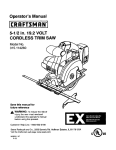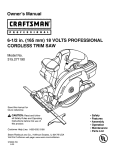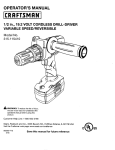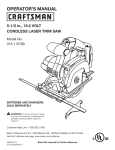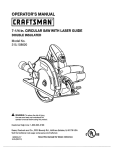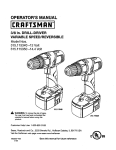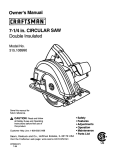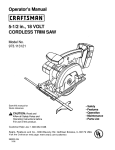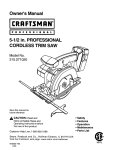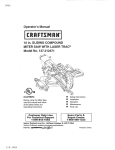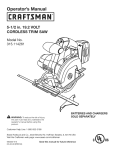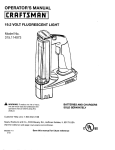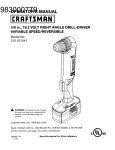Download Craftsman 315.114232 Operator`s manual
Transcript
OPERATOR'S MANUAL II:RRFTSMRN°I 5-1/2 in., 18 VOLT CORDLESS TRIM SAW Model No. 315.114232 _ WARNING: To reduce the risk of injury, the user must read and understand the operator's manual before using this product. Customer Help Line: 1-800-932-3188 Sears, Roebuck and Co., 3333 Beverly Rd., Hoffman Estates, IL 60179 Visit the Craftsman web page: www.sears.com/craftsman 983000-507 11-04 Save this manual for future reference USA • Warranty .......................................................................................................................................................................... 2 • Introduction ..................................................................................................................................................................... 2 • General Safety Rules .................................................................................................................................................... 3-4 • Specific Safety Rules .................................................................................................................................................... 4-5 • Safety Rules for Charger ................................................................................................................................................. • Symbols ........................................................................................................................................................................ • Features ...................................................................................................................................................................... 6 7-8 9-10 • Assembly .................................................................................................................................................................. 10-11 • Operation .................................................................................................................................................................. 12-19 • Maintenance .................................................................................................................................................................. 20 • Accessories ................................................................................................................................................................... 20 • Exploded View and Parts List ................................................................................................................................... • Par_sOrdering/Service .................................................................................................................................... FULL ONE YEAR WARRANTY ON CRAFTSMAN 21-22 Back Page TOOL If this CRAFTSMAN tool fails to give complete satisfaction within one year from the date of purchase, RETURN IT TO THE NEAREST SEARS STORE OR SEARS SERVICE CENTER IN THE UNITED STATES, and Sears will replace it, free of charge. If this CRAFTSMAN of purchase. tool is used for commercial or rental purposes, this warranty applies for only 90 days from the date This warranty gives you specific legal rights, and you may also have other rights which vary from state to state. Sears, Roebuck and Co., Dept. 817WA, Hoffman Estates, IL 60179 This tool has many features for making its use more pleasant and enjoyable. Safety, performance, and dependability have been given top priority in the design of this product making it easy to maintain and operate. _L WARNING! READ AND UNDERSTAND ALL INSTRUCTIONS. Failureto follow all instructions listed below, may result in electric shock, fire and/or serious personal injury. SAVE THESE WORK AREA Keep your work area clean and well lit. Cluttered benches and dark areas invite accidents. • Do not operate power tools in explosive atmospheres, such as in the presence of flammable liquids, gases, or dust. Power tools create sparks which may ignite the dust or fumes. Keep bystanders, children, and visitors away while operating a power tool. Distractions can cause you to lose control. ELECTRICALSAFETY • A battery operated tool with integral batteries or a separate battery pack must be recharged only with the specified charger for the battery. A charger that may be suitable for one type of battery may create a risk of fire when used with another battery. • Use battery operated tool only with specifically designated battery pack. Use of any other batteries may create a risk of fire. • Use battery MODEL 315.114232 • • • • only with charger Do not wear loose clothing or jewelry. Contain long hair. Loose clothes, jewelry, or long hair can be drawn into air vents. • Do not use on a ladder or unstable support. Stable footing on a solid surface enables better control of the tool in unexpected situations. TOOLUSEAND Use clamps support the the work by may lead to • Do not force tool. Use the correct tool for your application, The correct tool will do the job better and safer at the rate for which it is designed. Do not use tool if switch does not turn it on or off. A tool that cannot be controlled with the switch is dangerous and must be repaired. Disconnect battery pack from tool or place the switch in the locked or off position before making any adjustments, changing accessories, or storing the tool. Such preventive safety measures reduce the risk of starting the tool accidentally. Store idle tools out of reach of children and other untrained persons. Tools are dangerous in the hands of untrained users. • • • Do not abuse the cord. Never use the cord to carry the charger. Keep cord away from heat, oil, sharp edges, or moving parts. Replace damaged cords immediately. Damaged cords may create a fire. • SAFETY Stay alert, watch what you are doing and use common sense when operating a power tool. Do not use tool while tired or under the influence of drugs, alcohol, or medication. A moment of inattention while operating power tools may result in serious personal injury. Dress properly. Do not wear loose clothing jewelry. Contain long hair. Keep your hair, and gloves away from moving parts. Loose jewelry, or long hair can be caught in moving or clothing, clothes, parts. Avoid accidental starting. Be sure switch is in the locked or off position before inserting battery pack. Carrying tools with your finger on the switch or inserting the battery pack into a tool with the switch on invites accidents. Remove adjusting keys or wrenches before turning the tool on. A wrench or a key that is left attached to a rotating part of the tool may result in personal injury. CARE • listed. BATTERY PACK Item no. 9 11378 (130139020) Do not overreach. Keep proper footing and balance at all times. Proper footing and balance enable better control of the tool in unexpected situations. Use safety equipment. Always wear eye protection. Dust mask, non-skid safety shoes, hard hat, or hearing protection must be used for appropriate conditions. • CHARGER Item no. 9 11379 (1426101) PERSONAL • • INSTRUCTIONS • • • • or other practical way to secure and workpiece to a stable platform. Holding hand or against your body is unstable and loss of control. When battery pack is not in use, keep it away from other metal objects like: paper clips, coins, keys, nails, screws, or other small metal objects that can make a connection from one terminal to another. Shorting the battery terminals together may cause sparks, burns, or a fire. Maintain tools with care. Keep cutting tools sharp and clean. Properly maintained tools with sharp cutting edges are less likely to bind and are easier to control. • Check for misalignment or binding of moving parts, breakage of parts, and any other condition that may affect the tool's operation. If damaged, have the tool serviced before using. Many accidents are caused by poorly maintained tools. • Use only accessories that are recommended by the manufacturer for your model. Accessories that may be suitable for one tool may create a risk of injury when used on another tool. • Keep the tool and its handle dry, clean and free from oil and grease. Always use a clean cloth when cleaning. Never use brake fluids, gasoline, petroleumbased products, or any strong solvents to clean the tool. Following this rule will reduce the risk of loss of control and deterioration of the enclosure plastic. SERVICE • Tool service must be performed only by qualified repair personnel. Service or maintenance performed by unqualified personnel may result in a risk of injury. • When servicing a tool, use only identical replacement parts. Follow instructions in the Maintenance section of this manual. Use of unauthorizedparts or failure to follow Maintenance Instructionsmay create a risk of shock or injury. • DANGER! Keep hands away from cuffing area and blade. Keep your second hand on auxiliary handle or motor housing. If both hands are holdingthe saw, they cannot be cut by the blade. • When ripping always use a rip fence or an edge guide. This improves the accuracy of cut and reduces the chance of blade binding. • • Keep your body positioned to either side of the saw blade, but not in line with the saw blade. KICKBACK could cause the saw to jump backwards. Always use blades with correct size and shape (diamond vs. round) arbor holes. Bladesthat do not match the mounting hardware of the saw will run eccentrically,causing loss of control. • Do not reach underneath the work. The guard cannot protect you from the blade below the work. • • Check the lower guard for proper closing before each use. Do not operate saw if lower guard does not move freely and close instantly. Never clamp or tie the lower guard into the open position. If saw is accidentally dropped, lower guard may be bent. Raise the lower guard with the retracting handle and make sure it moves freely and does not touch the blade or any other part, in all angles and depths of cut. Never use damaged or incorrect blade washers or bolts. The blade washers and bolt were specially designedfor the saw,for optimum performanceand safety of operation. • Causes and Operator Prevention of Kickback: • • • Kickbackis a sudden reaction to a pinched, bound, or misaligned saw blade, causing an uncontrolledsaw to lift up and out of the workpiece toward the operator. When the blade is pinched or bound tightly by the kerr closing down, the blade stalls and the motor reaction drives the unit rapidly back toward the operator. Check the operation and condition of the lower guard spring. If the guard and the spring are not operating properly, they must be serviced before use. Lower guard may operate sluggishlydue to damaged parts, gummy deposits, or a buildupof debris. Lower guard should be retracted manually only for special cuts such as "Pocket Cuts" and "Compound Cuts". Raise lower guard by Retracting Handle. As soon as blade enters the material, lower guard must be released. For all other sawing, the lower guard should operate automatically. If the blade becomes twisted or misalignedin the cut, the teeth at the back edge of the blade can dig intothe top surface of the wood causing the blade to climb out of the kerf and jump back toward the operator. Kickbackis a result of tool misuse and/or incorrectoperating procedures or conditionsand can be avoided by taking proper precautionsas givenbelow: Always observe that the lower guard is covering the blade before placing saw down on bench or floor. An unprotected, coasting blade will cause the saw to walk backwards, cutting whatever is in its path. Be aware of the time it takes for the blade to stop after switch is released. • Maintain a firm grip on the saw and position your body and arm in a way that allows you to resist KICKBACK forces. KICKBACK forces can be controlled by the operator, if proper precautionsare taken. • When blade is binding, or when interrupting a cut for any reason, release the trigger and hold the saw motionless in the material until the blade comes to a complete stop. Never attempt to remove the saw from the work or pull the saw backward while the blade is in motion or KICKBACK may occur. Investigateand take correctiveactionsto eliminate the cause of blade binding. • When restarting a saw in the workpiece, center the saw blade in the kerf and check that teeth are not engaged into the material. If saw blade is binding, it may walk up or KICKBACK from the workpiece as the saw is restarted. NEVER hold piece being cut in your hands or across your leg. It is importantto support the work properly to minimize body exposure, blade binding, or loss of control. Hold tool by insulating gripping surfaces when performing an operation where the cutting tool may contact hidden wiring. Contact with a "live" wire will also make exposed metal parts of the tool "live" and shock the operator. 4 Additional Specific Safety Rules • Battery tools do not have to be plugged into an electrical outlet; therefore, they are always in operating condition. Be aware of possible hazards when not using the battery tool or when changing accessories. Following this rule will reduce the risk of electric shock, fire, or serious personal injury. • Do not place battery tools or their batteries near fire or heat. This will reduce the risk of explosion and possibly injury. • Support large panels to minimize the risk of blade pinching and KICKBACK. Large panels tend to sag under their own weight. Supports must be placed under the panel on both sides, near the line of cut and near the edge of the panel. • Do not use dull or damaged blade. Unsharpened or improperly set blades produce narrow kerr causing excessive friction, blade binding, and KICKBACK. • Blade depth and bevel adjusting locking levers must be tight and secure before making cut. If blade adjustment shifts while cutting, it will cause binding and KICKBACK. • • Use extra caution when making a "Pocket Cut" into existing walls or other blind areas, The protrudingblade may cut objectsthat can cause KICKBACK. • • Hold tool by insulated gripping surfaces when performing an operation where the cutting tool may contact hidden wiring. Contact with a "live" wire will also make exposed metal parts of the tool "live" and shock the operator. • Know the power tool. Read operator's manual carefully. Learn its applications and limitations, as well as the specific potential hazards related to this tool. Following this rule will reduce the risk of electric shock, fire, or serious injury. • Always wear safety glasses with side shields. Everyday glasses have only impact resistant lenses. They are NOT safety glasses. Following this rule will reduce the risk of eye injury. • Protect your lungs. Wear a face or dust mask if the operation is dusty. Following this rule will reduce the risk of serious personal injury. • Protect your hearing. Wear hearing protection during extended periods of operation. Following this rule will reduce the risk of serious personal injury. Never use a battery that has been dropped or received a sharp blow. A damaged battery is subject to explosion. Properly dispose of a dropped or damaged battery immediately. Batteries vent hydrogen gas and can explode in the presence of a source of ignition, such as a pilot light. To reduce the risk of serious personal injury, never use any cordless product in the presence of open flame. An exploded battery can propel debris and chemicals. If exposed, flush with water immediately. • Do not charge battery tool in a damp or wet location. Following this rule will reduce the risk of electric shock. • For best results, the battery tool should be charged in a location where the temperature is more than 50°F but less than IO0°F. Do not store outside or in vehicles. Under extreme usage or temperature conditions, battery leakage may occur. If liquid comes in contact with your skin, wash immediately with soap and water, then neutralize with lemon juice or vinegar. If liquid gets into your eyes, flush them with clean water for at least 10 minutes, then seek immediate medical attention. Following this rule will reduce the risk of serious personal injury. _k could result in a risk of fire and electric shock. If extension cord must be used, make sure: WARNING! READ AND UNDERSTAND ALL INSTRUCTIONS. Failureto follow all instructions listed below, may resultin electric shock, fire and/or serious personal injury. a. That pins on plug of extension cord are the same number, size and shape as those of plug on charger. • Before using battery charger, read all instructions and cautionary markings in this manual, on battery charger, battery, and product using battery to prevent misuse of the products and possible injury or damage. _i, b. That extension cord is properly wired and in good electrical condition; and c. That wire size is large enough for AC ampere rating of charger as specified below: CAUTION: To reduce the risk of electric shock or damage to the charger and battery, charge only nickel-cadmium rechargeable batteries as specifically designated on the charger. Other types of batteries may burst, causing personal injuryor damage. • Keep cord and charger from heat to prevent damage to housing or internal parts. • Do not let gasoline, oils, petroleum-based products, etc. come in contact with plastic parts. They contain chemicals that can damage, weaken, or destroy plastic. • An extension cord should not be used unless absolutely necessary. Use of improper extension cord A 25' 50' 100' Cord Size (AWG) 16 16 16 NOTE: AWG = American Wire Gauge Do not operate charger with a damaged cord or plug, which could cause shorting and electric shock. If damaged, have the charger replaced by an authorized serviceman. • Do not use charger outdoors or expose to wet or damp conditions. Water entering charger will increase the risk of electric shock. • Use of an attachment not recommended or sold by the battery charger manufacturer may result in a risk of fire, electric shock, or injury to persons, Following this rule will reduce the risk of electric shock, fire, or serious personal injury. • Do not abuse cord or charger. Never use the cord to carry the charger. Do not pull the charger cord rather than the plug when disconnecting from receptacle. Damage to the cord or charger could occur and create an electric shock hazard. Replace damaged cords immediately. • Make sure cord is located so that it will not be stepped on, tripped over, come in contact with sharp edges or moving parts or otherwise subjected to damage or stress. This will reduce the risk of accidental falls, which could cause injury, and damage to the cord, which could result in electric shock. Cord Length (Feet) Do not operate charger if it has received a sharp blow, been dropped, or otherwise damaged in any way. Take it to an authorized servicemanfor electrical check to determine if the charger is in good working order. Do not disassemble charger. Take it to an authorized serviceman when service or repair is required. Incorrect reassembly may result in a risk of electric shock or fire. • Unplug charger from outlet before attempting any maintenance or cleaning to reduce the risk of electric shock, • Disconnect charger from the power supply when not in use. This will reduce the risk of electric shock • or damage to the charger if metal items should fall into the opening. It also will help prevent damage to the charger during a power surge. Risk of electric shock. Do not touch uninsulated portion of output connector terminal. or uninsulated battery Save these instructions. Refer to them frequently and use them to instruct others who may use this tool. If you loan someone this tool, loan them these instructions also to prevent misuse of the product and possible injury. WARNING: Some dust created by power sanding, sawing, grinding, drilling, and other construction activities contains chemicals known to cause cancer, birth defects or other reproductive harm. Some examples of these chemicals are: • lead from lead-based paints, • crystalline silica from bricks and cement and other masonry products, and • arsenic and chromium from chemically-treated lumber. Your risk from these exposures varies, depending on how often you do this type of work. To reduce your exposure to these chemicals: work in a well ventilated area, and work with approved safety equipment, such as those dust masks that are specially designed to filter out microscopic particles. Some of the following symbols may be used on this tool. Please study them and learn their meaning. interpretation of these symbols will allow you to operate the tool better and safer. SYMBOL NAME DESIGNATION/EXPLANATION V Volts Voltage A Amperes Current Hz Hertz Frequency W Watt Power Minutes Time min Alternating Current (cycles per second) Type of current Direct Current Type or a characteristic no No Load Speed Rotational [] Class II Construction Double-insulated .../min Per Minute Revolutions, @ Wet Conditions Alert Read The Operator's Q A Manual of current speed, at no load construction strokes, Do not expose surface speed, orbits etc., per minute to rain or use in damp locations. To reduce the risk of injury, user must read and understand operator's manual before using this product. Eye Protection Always shields Safety Precautions Alert Proper wear safety goggles or safety glasses with side and a full face shield when operating this product. that involve your safety. No Hands Symbol Failure to keep your hands away from the blade will result in serious personal injury. No Hands Symbol Failure to keep your hands away from the blade will result in serious personal injury. No Hands Symbol Failure to keep your hands away from the blade will result in serious personal injury. ,_ No Hands Symbol Failure to keep your hands away from the blade will result in serious personal injury. (_) Hot Surface To reduce the risk of injury or damage, any hot surface. _) 7 avoid contact with Thefollowing signalwordsandmeanings areintended toexplain thelevelsofriskassociated withthisproduct. SYMBOL SIGNAL MEANING ,_ DANGER: Indicates an imminently hazardous situation, which, if not avoided, will result in death or serious injury. _i, WARNING: Indicates a potentially hazardous situation, which, if not avoided, could result in death or serious injury. ,_, CAUTION: Indicates a potentially hazardous situation, which, if not avoided, may result in minor or moderate injury. CAUTION: (Without Safety Alert Symbol) Indicates a situation that may result in property damage. SERVICE Servicing requires extreme care and knowledge and should be performed only by a qualified service technician. For service we suggest you return the product to your nearest AUTHORIZED SERVICE CENTER for repair. When servicing, use only identical replacement parts. _, _1, WARNING: To avoid serious personal injury, do not attempt to use this product until you read thoroughly and understand completely the operator's manual. Save this operator's manual and review frequently for continuing safe operation and instructingothers who may use this product. WARNING: 0 The operation of any power tool can result in foreign objects being thrown into your eyes, which can result in severe eye damage. Before beginning power tool operation, always wear safety goggles or safety glasses with side shields and a full face shield when needed. We recommend Wide Vision Safety Mask for use over eyeglasses or standard safety glasses with side shields. Always use eye protection which is marked to comply with ANSI Z87.1. SAVE THESE INSTRUCTIONS 8 PRODUCT SPECIFICATIONS Motor ...................................................................................................................................................................... Blade Diameter .......................................................................................................................................................... Blade Arbor.................................................................................................................................................................... 18 Volt DC 5-1/2 in, 3/8 in. Cutting Depth at 900 ................................................................................................................................................. 1-9/16 in. Cutting Depth at 45° ................................................................................................................................................... 1-1/8 in. No Load Speed ...................................................................................................................................................... 4,500/min. Charger Input ....................................................................................................................................... 120 V, 60 Hz, AC only Charge Rate ............................................................................................................................................................ 3-6 Hours BLADE WRENCH STORAGEAREA BLADEWRENCH (5 mmHEXKEY) LOCK-OFF BUTTON BATTERY PACK DEPTH OF CUTADJUSTMENT (DEPTH ADJUSTMENTKNOB) SPINDLE LOCK BUTTON SWITCH TRIGGER EDGEGUIDESCREW (WINGSCREW) UPPER LOWER BLADE GUARDHANDLE LOWER BLADEGUARD BEVELCUTADJUSTMENT (BEVELADJUSTMENT KNOB) BASE ASSEMBLY BLADE Fig. 1 KNOW THE TRIM See Figure 1. SAW SPINDLE LOCK BUTI'ON Depressing the spindle lock button will allow you to install or replace the saw blade without the spindle turning. Press the spindle lock button and use the blade wrench to tighten or loosen the blade screw. Before attempting to use this product, familiarizeyourself with all operating features and safety rules. SWITCH LOWER BLADE GUARD The saw is equipped with a lock-off button which reduces the possibility of accidental starting. The lock-off button is located on the handle above the switch trigger.You must depress the lock-off button in order to pull the switch trigger. The lock resets each time the trigger is released. The lower blade guard will protect the saw blade when the saw is not in use. It will rotate out of the way when making a cut. LOWER BLADE GUARD HANDLE NOTE: You can depress the lock-off button from either the left or right side. The lower blade guard has a handle attached to it allowing you to rotate the lower blade guard out of the way to install or replace the saw blade, it is also used when making a pocket cut to expose the saw blade. UNPACKING _k This product requires assembly. • Carefully remove the tool and any accessories from the box. Make sure that all items listed in the packing list are included. d_lL WARNING: Do not attempt to modify this tool or create accessories not recommended for use with this tool. Any such alteration or modification is misuse and could result in a hazardous condition leading to possible serious personal injury. • Inspect the tool carefully to make sure no breakage or damage occurred during shipping. • Do not discard the packing material until you have carefully inspected and satisfactorily operated the tool. • If any parts are damaged or missing, please call 1-800-932-3188 for assistance. PACKING WARNING: If any parts are missing do not operate this tool until the missing parts are replaced. Failure to do so could result in possible serious personal injury. _lb LIST Cordless Trim Saw Battery Pack Charger Blade Blade Wrench Case Operator's Manual 10 WARNING: To prevent accidental starting that could cause serious personal injury, always remove the battery pack from the tool when assembling parts. SPINDLE LOCKBUTTON NOTE: The saw is assembled with the battery pack attached. LOWERBLADE GUARDHANDLE TO REMOVE BATTERY PACK See Figure 2. • Locate latches on side of battery pack and depress to release battery pack from the saw. • Remove battery pack from the saw. TO ASSEMBLE OR REMOVE TO ASSEMBLE See Figure 3. BLADE: _k BLADE WARNING: A 5-1/2 in. blade is the maximum blade capacity of the saw. Never use a blade that is too thick to allow outer blade washer to engage with the flats on the spindle. Larger blades will come in contact with the blade guard, while thicker blades will prevent blade screw from securing blade on spindle. Either of these situations could result in a serious accident, DEPRESSLATCHESTO RELEASEBATTERYPACK TO INNER BLADEWASHER OUTER BLADE WASHER BLADESCREW Fig. 3 • Fit saw blade inside lower blade guard and onto spindle. NOTE: The saw teeth point upward at the front of saw as shown in figure 3. TO INSTALL • Depress spindle lock button, then replace blade screw. Tighten blade screw securely. • Return blade wrench to storage area. REMEMBER: Never use a blade that is too thick to allow the outer blade washer to engage with the flats on the spindle. Fig. 2 • • Remove battery pack from saw. Locate latches on side of battery pack and depress to release battery pack from the saw. • Remove blade wrench (5 mm hex key) from storage area. • Depress spindle lock button and remove blade screw and outer blade washer. NOTE: Turn blade screw clockwise to remove. _k Replace outer blade washer. NOTE: Turn blade screw counterclockwise to tighten, LATCHES BATrERY PACK • • Wipe a drop of oil onto inner blade washer and outer blade washer where they contact blade. WARNING: If inner blade washer has been removed, replace it before placing blade on spindle. Failure to do so could cause an accident since blade will not tighten properly. 11 _ WARNING: Do not allow familiarity with tools to make you careless. Remember that a careless fraction of a second is sufficient to inflict serious injury. _ WARNING: Always wear safety goggles or safety glasses with side shields when operating tools. Failure to do so could result in objects being thrown into your eyes, resulting in possible serious injury. • The charge indicator light (LED), located on the charging stand, will light up red and glow when the charger is properly connected to power supply. This light indicates the charger is operating properly. It will remain on until battery pack is removed from charging stand or charger is disconnected from power supply. NOTE: If charger does not charge battery pack, return battery pack and charging assembly to your nearest Sears Repair Center for electrical check. • After normal usage, 3 hours or less of charging time is required to fully recharge battery pack. _i WARNING: Do not use any attachments or accessories not recommended by the manufacturer of this tool. The use of attachments or accessories not recommended can result in serious personal injury. NOTE: If battery pack is completely discharged, 6 hours or longer of charging time is required to fully recharge battery pack. • The battery pack will become slightly warm to the touch while charging. This is normal and does not indicate a problem. APPLICATIONS You may use this tool for the following purposes: • • Cutting all types of wood products (lumber, plywood, paneling) • When batteries become fully charged, unplug charger from power supply and remove the battery pack. CAUTION: To prevent damage to the battery pack, remove the battery pack from the charger immediately if no LED comes on. Return the battery pack and charger to your nearest service center for checking or replacing. Also, if you are removing the battery pack from the charger and no LEDs are on, return both the battery pack and the charger to your nearest service center. Do not insert another battery pack into the charger. A damaged charger may damage a battery pack. CHARGING THE BATTERY Do not place charger in an area of extreme heat or cold. It will work best at normal room temperature. CHARGING A HOT BATTERY PACK When using the tool continuously, the batteries in the battery pack will become hot. You should let a hot battery pack cool down for approximately 30 minutes before attempting to recharge. NOTE: This situation only occurs when continuous use of the tool causes the batteries to become hot. It does not occur under normal circumstances. Refer to "CHARGING THE BATTERY PACK" for normal recharging of batteries. If the charging assembly does not charge the battery pack under normal circumstances, return both the battery pack and charging assembly to your nearest Sears Repair Center for electrical check. PACK See Figure 4. The battery pack for this tool has been shipped in a low charge condition to prevent possible problems. Therefore, you should charge overnight prior to use. ADAPTER BATTERY NOTE: Batteries will not reach full charge the first time they are charged. Allow several cycles (operation followed by recharging) for them to become fully charged. \ • Charge battery pack only with the charging assembly provided. • Make sure power supply is normal household voltage, 120 volts, 60 Hz, AC only. • Connect charger to power supply. • Place battery pack in charging stand. Align raised rib on battery pack with groove in charging stand. • Press down on battery pack to be sure contacts on battery pack engage properly with contacts in charging stand. CHARGEINDICATOR LIGHT 12 Fig. 4 TO INSTALL BATTERY PACK DEPRESSSPINDLE LOCK BuI"rON See Figure 5. NOTE: Battery pack is shipped in a low charge condition. Therefore, it must be charged prior to use. Refer to page 12, "Charging Battery Pack" for charging instructions. • • Place battery pack in the saw. Align raised rib on battery pack with groove inside saw, then slide battery pack in saw as shown in figure 4. TO LOOSEN Make sure the latches on each side of the battery pack snap into place and battery pack is secured in saw before beginning operation. BLADE SCREW \ TO TIGHTEN Fig. 6 BLADE GUARD SYSTEM See Figure 7. The lower blade guard attached to the trim saw is there for your protection and safety. It should never be altered for any reason. If it becomes damaged or begins to return slow or sluggish, do not operate the saw until the damage has been repaired or replaced. Always leave guard in operating position when using saw. LATCHES BATrERYPACK Fig. 5 ,_ ,_ CAUTION: When placing battery pack in the saw, be sure raised rib on battery pack aligns with groove inside saw and latches snap into place properly. Improper assembly can cause damage to saw and battery pack. TO REMOVE See Figure 6. Remove battery pack from saw. • Remove blade wrench from storage area. • Position saw as shown in figure 6, depress spindle lock button, and remove blade screw. NOTE: Turn blade screw clockwise to remove. • Remove outer blade washer. LOWER BLADEGUARD IS IN UP POSITION WHEN MAKINGA CUT NOTE: Blade can be removed at this point. ,_k DANGER: When sawing through workpiece, lower blade guard does not cover blade on the underside of workpiece. Since blade is exposed on undersideof workpiece, keep hands and fingers away from cutting area. Any part of your body coming in contact with moving blade will result in serious injury. Never use saw when guard is not operating correctly. Guard should be checked for correct operation before each use. if you drop the saw, check the lower blade guard and bumper for damage at all depth settings before reuse. NOTE: The guard is operating correctly when it moves freely and readily returns to the closed position. If for any reason the lower blade guard does not close freely, take it to the nearest Sears Service Center for service before using. BLADE • BLADE WRENCH WARNING: Battery tools are always in operating condition. Therefore, switch should always be locked when not in use or carrying at your side. BLADE EXPOSEDON UNDERSIDE OF WORKPIECE 13 Fig. 7 KICKBACK TO LESSEN THE CHANCE See Figure 1I. See Figures 8 - 11. OF KICKBACK: • Always keep the correct blade depth setting - the correct blade depth setting for all cuts should not exceed 1/4 in. below the material to be cut. One blade tooth below the material to be cut works best for most efficient cutting action. BLADESETTOODEEP Fig. 8 The best guard against kickback is to avoid dangerous practices. Kickback occurs when the blade stalls rapidly and the saw is driven back towards you. Blade stalling is caused by any action which pinches the blade in the wood. ,_ DANGER: Release switch immediately if blade binds or saw stalls. Kickback could cause you to lose control of the saw. Loss of control can lead to serious injury. CORRECTBLADEDEPTHSE'mNG= BLADEEXPOSEDONEBLADETOOTH BELOWTHEMATERIALTOBECUT Fig. 10 KICKBACK IS CAUSED BY: • Incorrect blade depth setting. • Sawing into knots or nails in workpiece. • Twisting blade while making a cut. • Making a cut with a dull, gummed up, or improperly set blade. • • • Inspect the workpiece for knots or nails before beginning a cut. Never saw into a knot or nail. • Make straight cuts. Always use a straight edge guide when rip cutting. This helps prevent twisting the blade in the cut. Always use clean, sharp and properly set blades. Never make cuts with dull blades. Incorrectly supporting workpiece. Forcing a cut. To avoid pinching the blade, support the workpiece properly before beginning a cut. The right and wrong ways to support large pieces of work are shown in figures 9 and 11. Fig. 9 • Cutting warped or wet lumber. • Tool misuse or incorrect operating procedures. RIGHT 14 Fig. 11 • Whenmakinga cutusesteady, evenpressure. Neverforcecuts. • Donotcutwarpedorwetlumber. • Alwaysholdthesawfirmlywithbothhandsandkeep yourbodyina balanced position soastoresistthe forcesofkickback shoulditoccur. STARTING A CUT See Figure 13. Know the right way to use the saw. Never use the saw as shown in figure 14. Never place your hand on the workpiece behind the saw while making a cut. When using the saw, always stay alert and exercise control. Do not remove the saw from workpiece while the blade is moving. DEPTH OF CUT ADJUSTMENT Always keep correct blade depth setting. The correct blade depth setting for all cuts should not exceed 1/4 inch below the material to be cut. More blade depth will increase the chance of kickback and cause the cut to be rough, One blade tooth below the material to be cut works best for most efficient cutting action. TO ADJUST See Figurel_ BLADE \ DEPTH • • Remove battery pack from saw, Loosen depth adjustment knob. • Hold base flat against the workpiece and raise or lower saw until the required depth is reached. • Tighten depth adjustment knob securely. Fig. 13 _ TO RAISE SAW WARNING: To make sawing easier and safer, always maintain proper control of the saw. Loss of control of the saw could cause an accident resulting in possible serious injury. BASE ASSEMBLY TO LOWERSAW TO LOOSEN TIGHTEN DEPTH ADJUSTMENT KNOB Fig. 12 WRONG 15 Fig. 14 TO HELP MAINTAIN CONTROL Depress the lock-off button and squeeze the switch trigger to start the saw. Always let the blade reach full speed, then guide the saw into the workpiece. See Figures 15 - 16. • Always support the workpiece near the cut, • Support the workpiece so the cut will be on your left. • Clamp the workpiece so it will not move during the cut. Place the workpiece with its good side down. NOTE: The good side is the side on which appearance is important. \ Before beginning a cut, draw a guideline along the desired line of cut.Then place front edge of base on that part of the workpiece that is solidly supported. Never place the saw on that part of the workpiece that will fall off when the cut is made. Hold the saw firmly with both hands. RIGHT _i Fig. 16 WARNING: The blade coming in contact with the workpiece before it reaches full speed could cause the saw to "kickback" towards you resulting in serious injury. When making a cut use steady, even pressure. Forcing causes rough cuts, could shorten the life of the saw and could cause "kickback," WRONG REMEMBER: When sawing through work, the lower blade guard does not cover the blade, exposing it on the underside of work, Keep the hands and fingers away from cutting area. Any part of your body coming in contact with the moving blade will result in serious injury. After you complete the cut release the trigger and allow the blade to come to a complete stop. Do not remove the saw from workpiece while the blade is moving. Fig. 15 ,_i 16 CAUTION: When lifting the saw from the workpiece, the blade is exposed on the underside of the saw until the lower blade guard closes. Make sure lower blade guard is closed before setting the saw down on work surface. TO CROSS CUT OR RIP CUT A width of cut scale has been provided on the base of the saw. When making straight cross cuts or rip cuts, the scale can be used to measure up to four inches to the right side of the blade. It can be used to measure up to one inch to the left side of the blade. See Figure 17. When making a cross cut or rip cut, align the line of cut with the outer blade guide notch on the saw base. TOP VIEW OF SAW EDGE GUIDE See Figure 19. GUIDELINE BLADE GUIDE NOTCH Use the optional edge guide with the saw when making wide rip cuts. A five inch scale has been provided on the edge guide. When using the width of cut scale on the base in combination with the edge guide, cuts can be made up to 6 in. to the left of the edge guide or 8-7/8 in. to the right of the edge guide. The edge guide helps prevent the blade from twisting in a cut. The blade twisting in a cut can cause kickback. -.FRO" TT i OFSAW ,I TO ASSEMBLE 'd! EDGE GUIDE See Figure 19. • Remove battery pack from saw. ALIGN OUTER BLADE GUIDENOTCHON SAW BASEWITH LINE OF CUT AS SHOWN WHEN MAKINGCROSS CUTS OR RIP CUTS Fig. 17 Since blade thicknessesvary, always make a trial cut in scrap material along a guideline to determine how much, if any, the guideline must be offset to produce an accurate cut. NOTE: The distance from the line of cut to the guideline is the amount you should offset the guideline. WIDTH OF CUT SCALE See Figure 18. G°'DE BASE ASSEMBLY Fig. 19 • Place edge guide through holes in saw base. • Adjust edge guide to the width needed. • Tighten edge guide screw (wing screw) securely. WIDTH OF CUT SCALE When using an edge guide, position the face of the edge guide firmly against the edge of workpiece. This makes for a true cut without pinching the blade. The guiding edge of workpiece must be straight for the cut to be straight. Use caution to prevent the blade from binding in the cut. BLADE Fig. 18 17 ALTERNATIVE See Figure20. RIP METHOD Align the line of cut with the inner blade guide notch on the saw base when making 45 ° bevel cuts. Since blade thicknesses vary and different angles require different settings, always make a trial cut in scrap material along a guideline to determine how much you should offset the guideline on the board to be oat. Using C-clamps, firmly clamp a straight edge to the workpeice and guide the saw along the straight edge to achieve a straight rip cut. Do not bind the blade in the cut. WORKPIECE When making a bevel cut hold the saw firmly with both hands as shown in figure 22. STRAIGHT EDGE \ C-CLAMPBOTHENDSOF STRAIGHTEDGEBEFORE MAKINGCUT Fig. 20 ALTERNATIVE METHODFORRIP cu'n'ING LOWER BLADEGUARD Fig. 22 TO BEVEL CUT See Figures 21 - 22. Rest the front edge of the base on the workpiece. Depress the lock-off button and squeeze the switch trigger to start the saw. Always let the blade reach full speed, then guide the saw into the workpiece. The angle of cut of the saw may be adjusted to any desired setting between zero and 50 °. NOTE=When making cuts at 50 °, blade should be set at full depth of cut. WARNING: The blade coming in contact with the workpiece before it reaches full speed could cause saw to "kickback" toward you resulting in serious injury. When making 45 ° bevel cuts, there is a notch in the saw base to help you line up the blade with the line of cut. I BEVEL ADJUSTMENT KNOB After you complete the cut release the trigger and allow the blade to come to a complete stop, After the blade has stopped, lift the saw from the workpiece. II I II. TO ADJUST BEVEL SETTING See Figure 21. BEVEL_/""'"_ J_P"hl_, _'_ ///J ,?,d, ,ll'll_//,, _ • Remove battery pack from saw. • Loosen bevel adjustment knob. • Raise motor housing end of saw until you reach desired angle setting on bevel scale. • Tighten bevel adjustment knob securely. l; ,rGU'DEL'NE: ?:,F ,_ [ I1_ /V_/ I t7 _',_,'J /,'; /vvlr/vh ALIGNINNERBLADEGUIDENOTCHONSAWBASEWITH LINEOFCUTASSHOWNWHENMAKING45° BEVELCUTS Fig. 21 18 WARNING: Attempting bevel cut without knob securely tightened can result in serious injury. POSITIVE 0 ° BEVEL STOP See Figure 23. ADJUSTMENT SCREW TO POCKET CUT See Figure 24. ,_ BEVEL ADJUSTMENT KNOB WARNING" Always adjust bevel setting to zero before making a pocket cut. Attempting a pocket cut at any other setting can result in loss of control of the saw possibly causing serious injury. Adjust the bevel setting to zero, set blade to correct blade depth setting, and swing the lower blade guard up using the lower blade guard handle. HEX NUT Always raise the lower blade guard with the handle to avoid serious injury. BLADE While holding lower blade guard by the handle, firmly rest the front of the base flat against the workpiece with the rear of the handle raised so the blade does not touch the workpiece. POSITIVE0° BEVELSTOP LOWERBLADE GUARDHANDLE COMBINATION SQUARE Fig. 23 The saw has a positive O° bevel stop that has been factory adjusted to assure 0° angle of the saw blade when making 90 ° cuts. However, misalignment can occur during shipping. POCKETCUT TO CHECK • Remove battery pack from saw. • Place the saw in an upside down position on workbench. • Using a combination square, check squareness of saw blade to the base of the saw. Remove battery pack from saw. • Loosen bevel adjustment knob. • Loosen hex nut securing adjustment screw. After you complete the cut, release the trigger and allow the blade to come to a complete stop. After the blade has stopped, remove it from the workpiece. Corners may then be cleared out with a hand saw or sabre saw. • Turn screw and adjust base until square with saw blade. ,_ • Tighten hex nut and bevel adjustment knob securely. ,_, Fig. 24 Depress the lock-off button and squeeze the switch trigger to start the saw. Always let the blade reach full speed then slowly lower blade into the workpiece until base is flat against workpiece. TO ADJUST • LOWERBLADE GUARD WARNING: Attempting to make cuts without bevel adjustment knob securely tightened can result in serious injury. 19 WARNING: Never tie the lower blade guard in a raised position.Leaving the blade exposed could lead to serious injury. ,_ WARNING: When servicing, use only identical Craftsman replacement parts. Use of any other part may create a hazard or cause product damage. _ WARNING: Always wear safety goggles or safety glasses with side shields when using compressed air to clean tools. If the operation is dusty, also wear a dust mask. _IL _k WARNING: Do not at any time let brake fluids, gasoline, petroleum-based products, penetrating oils, etc. come in contact with plastic parts. Chemicals can damage, weaken or destroy plastic which may result in serious personal injury. Only the parts shown on the parts list are intended to be repaired or replaced by the customer. All other parts should be replaced at a Sears Service Center. WARNING: To avoid serious personal injury, always remove the battery pack from the tool when cleaning or performing any maintenance. GENERAL MAINTENANCE Avoid using solvents when cleaning plastic parts. Most plastics are susceptible to damage from various types of commercial solvents and may be damaged by their use. Use clean cloths to remove dirt, dust, oil, grease, etc. BATTERIES BATTERY The battery pack for this tool is equipped with nickel-cadmium rechargeable batteries. Length of service from each charging will depend on the type of work you are doing. PREPARATION PACK REMOVAL To preserve natural resources, please recycle or dispose of batteries properly. The batteries in this tool have been designed to provide maximum trouble-free life. However, like all batteries, they will eventually wear out. Do not disassemble battery pack and attempt to replace the batteries. Handling of these batteries, especially when wearing rings and jewelry, could result in a serious burn. This product contains nickel-cadmium batteries. Local, state or federal laws may prohibit disposal of nickelcadmium batteries in ordinary trash. Consult your local waste authority for information regarding available recycling and/or disposal options. To obtain the longest possible battery life, we suggest the following: • Remove the battery pack from the charger once it is fully charged and ready for use. For battery pack storage longer than 30 days: ,_k • Store the battery pack where the temperature is below 80°F. • Store battery packs in a "discharged" condition. WARNING: Upon removal, cover the battery pack's terminals with heavy-duty adhesive tape. Do not attempt to destroy or disassemble battery pack or remove any of its components. Nickel-cadmium batteries must be recycled or disposed of properly. Also, never touch both terminals with metal objects and/or body parts as short circuit may result. Keep away from children. Failure to comply with these warnings could result in fire and/or serious injury. The following recommended accessories are currently available at Sears Retail Stores. • 5-1/2 in.Thin Kerf Blade • _k Edge Guide WARNING: AND FOR RECYCLING The use of attachments or accessories not listed might be hazardous. 20 CRAFTSMAN 18 VOLT CORDLESS TRIM SAW - MODEL NUMBER 315.114232 29 I L 28 11 12 15 6 27 16 17 13 14 18 21 19 20 30 22 5 2 23 4 32 3 21 CRAFTSMAN 18 VOLT CORDLESS TRIM SAW - MODEL NUMBER 315.114232 I The model number will be found on a plate attached to the motor housing. Always mention the model number in all correspondence regarding your CORDLESS TRIM SAW or when ordering repair parts. SEE BACK PAGE FOR PARTS ORDERING ] INSTRUCTIONS PARTS LIST Key No. Pa_ Number Description Key No. Quan. Part Number Description Quan. 1 6614301 Carriage Bolt (M6 x 100 mm) ....................... 1 18 6850303 Bearing Retainer .......................................... 1 2 670956015 Base Assembly ............................................ 1 19 6620104 * Screw (M2.6 x 10 mm Pan Hd.)................... 4 3 6614501 * Screw (M6 x 16 mm) .................................... 1 20 6112004 Inner Blade Washer ..................................... 1 4 5224502 Knob ............................................................ 2 21 *** Saw Blade ................................................... 1 5 6800101 Spring .......................................................... 1 22 6112101 Outer Blade Washer .................................... 1 6 520177001 6614401 Blade Screw ................................................ 1 6797401 Wing Screw ................................................. 1 Lock Nut ...................................................... 2 23 7 24 **Item No.£ 8 6802201 Hex Nut ........................................................ 1 25 **Item No.911378 9 6621204 * Screw (M4 x 16 mm Pan Hd.) ...................... 1 26 6800201 Blade Wrench (5 mm Hex Key).................... 1 10 6614201 * Carriage Bolt (M6 x 13 mm) ......................... 1 27 670957001 Edge Guide (Not Included) .......................... 1 11 640556013 Upper Blade Guard ..................................... 1 28 9427205 Logo Plate ................................................... 1 12 6620803 * Screw (M4 x 22 mm Pan Hd.) ...................... 4 29 940271024 Data Plate .................................................... 1 13 5217802 Bumper ........................................................ 1 30 680027001 Washer ......................................................... 1 14 6619302 Bumper Screw (M5 x 15.5 ram)................... 1 31 9429817 Warning Label .............................................. 1 15 6867201 Torsion Spring .............................................. 1 32 5228001 Washer ......................................................... 2 16 550994007 Lower Blade Guard ...................................... 1 3009102145 Combo Case (Not Shown) 17 6807001 Ball Bearing (NTN #6000ZZ) ........................ 1 983000507 Operator's Manual (Not Shown) * Standard Hardware ** Can Be Purchased *** Complete Assortment Item -- May Be Purchased 11379 Charger (1426101) ....................................... 1 Battery Pack (130139020) ........................... 1 Locally Thru RSOS (Retail Special Order System) Available At Your Nearest Sears Retail Store 22























